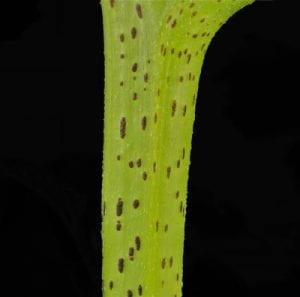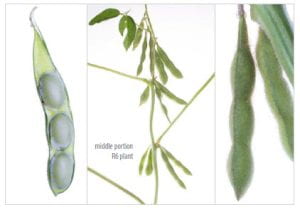Every year it seems as if we have one weed that that hasn’t really been a problem for a while suddenly pop up everywhere. This year Cocklebur wins the 2023 award for Comeback Weed of the Year!
Family: Asteraceae (Composite family)
Life cycle: Annual
Description: Erect plant reaching heights of 6 to 7 ft. Stems are rough with dark spots. Leaves are rough, triangular in shape with wavy or toothed margins and long petioles. Inconspicuous flowers produce egg-shaped burs with two beaks at end. Seedling has long, fleshy cotyledons.

Seedlings: The stem below the cotyledons (hypocotyl) is purple at the base and often green in the upper portion. Cotyledons are linear to oblong in outline, waxy, smooth, fleshy, thick, approximately 3/4 to1 3/4 inches long and usually no more than 1/2 inch wide. The first true leaves are opposite, while all subsequent leaves are alternate.
Roots: Taproot
 Stem: Mature stems are green, 1-4 ft. tall, highly branched, hairy, and flecked with maroon to black spots. Ridges are present on the stem. Upright hairs cause leaves to feel abrasive and gritty.
Stem: Mature stems are green, 1-4 ft. tall, highly branched, hairy, and flecked with maroon to black spots. Ridges are present on the stem. Upright hairs cause leaves to feel abrasive and gritty.

Leaves: The first true leaves are opposite, all subsequent leaves are alternate. Leaves are triangular to ovate in outline, have stiff hairs, and are approximately 2 to 6 inches long. Leave are irregularly lobed with leaf margins that have relatively inconspicuous teeth. Leaves occur on long petioles and also have three prominent veins on the upper surface of the leaf that arise from the same point.
 Flower/Seedhead: Inconspicuous, greenish in color, arising from the area between the leaf petioles and the stems (axillary flowers) and at the ends of the erect stems (terminal flowers).
Flower/Seedhead: Inconspicuous, greenish in color, arising from the area between the leaf petioles and the stems (axillary flowers) and at the ends of the erect stems (terminal flowers).
Special Identifying Characteristics: The relatively large, linear to oblong waxy cotyledons helps to distinguish this weed in the early stages of development. Additionally, the long-petioled triangular leaves, stems with maroon to black stem lesions, and the distinctive prickly cocklebur fruit are all features that help in the identification of this weed.In the early stages of development, this weed might be confused with Giant Ragweed (Ambrosia trifida), however the cotyledons of common cocklebur are much longer and more linear than those of giant ragweed. Spiny Cocklebur (Xanthium spinosum) is a closely related and similar species, however, unlike common cocklebur, this weed has very distinctive 3-parted spines that arise at the base of each leaf.
If you have a dog, you will now if you have cocklebur!

 fall period for alfalfa has been said to start about six weeks before the first killing frost, which is roughly around the first week of September for most of the Midwest. This hard stop in harvest schedules is supposed to ensure plants store enough energy in their roots to survive the winter, but with improved alfalfa varieties, variable stand conditions, and warmer weather patterns, how critical can this period really be?
fall period for alfalfa has been said to start about six weeks before the first killing frost, which is roughly around the first week of September for most of the Midwest. This hard stop in harvest schedules is supposed to ensure plants store enough energy in their roots to survive the winter, but with improved alfalfa varieties, variable stand conditions, and warmer weather patterns, how critical can this period really be? costs to farm have been continually rising for many years. The U.S. Department of Agriculture’s (USDA) February 2023 Farm Sector Income forecast projected total farm production expenses in 2023 at nearly $500 billion, up 4% from the prior year, but up $87 billion, or more than 28%, from 2020. For those raising livestock, looking outside of the typical commodity markets and focusing on direct-to-consumer meat sales may be an opportunity to increase revenue.
costs to farm have been continually rising for many years. The U.S. Department of Agriculture’s (USDA) February 2023 Farm Sector Income forecast projected total farm production expenses in 2023 at nearly $500 billion, up 4% from the prior year, but up $87 billion, or more than 28%, from 2020. For those raising livestock, looking outside of the typical commodity markets and focusing on direct-to-consumer meat sales may be an opportunity to increase revenue.















 Stem: Mature stems are green, 1-4 ft. tall, highly branched, hairy, and flecked with maroon to black spots. Ridges are present on the stem. Upright hairs cause leaves to feel abrasive and gritty.
Stem: Mature stems are green, 1-4 ft. tall, highly branched, hairy, and flecked with maroon to black spots. Ridges are present on the stem. Upright hairs cause leaves to feel abrasive and gritty.
 Flower/Seedhead: Inconspicuous, greenish in color, arising from the area between the leaf petioles and the stems (axillary flowers) and at the ends of the erect stems (terminal flowers).
Flower/Seedhead: Inconspicuous, greenish in color, arising from the area between the leaf petioles and the stems (axillary flowers) and at the ends of the erect stems (terminal flowers).